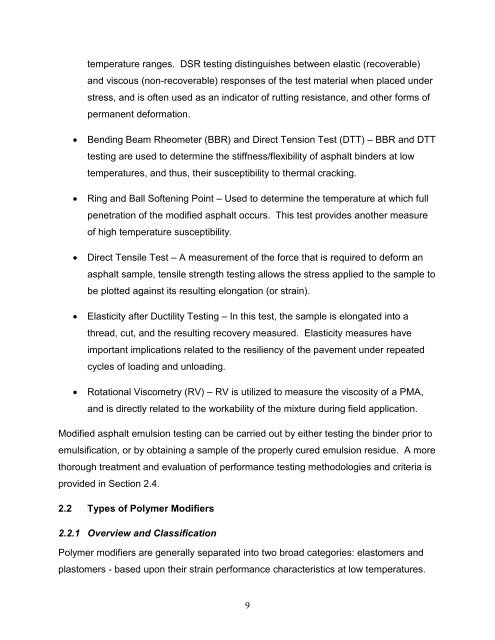Using Polymer Modified Asphalt Emulsions in Surface Treatments A ...
Using Polymer Modified Asphalt Emulsions in Surface Treatments A ...
Using Polymer Modified Asphalt Emulsions in Surface Treatments A ...
You also want an ePaper? Increase the reach of your titles
YUMPU automatically turns print PDFs into web optimized ePapers that Google loves.
temperature ranges. DSR test<strong>in</strong>g dist<strong>in</strong>guishes between elastic (recoverable)<br />
and viscous (non-recoverable) responses of the test material when placed under<br />
stress, and is often used as an <strong>in</strong>dicator of rutt<strong>in</strong>g resistance, and other forms of<br />
permanent deformation.<br />
• Bend<strong>in</strong>g Beam Rheometer (BBR) and Direct Tension Test (DTT) – BBR and DTT<br />
test<strong>in</strong>g are used to determ<strong>in</strong>e the stiffness/flexibility of asphalt b<strong>in</strong>ders at low<br />
temperatures, and thus, their susceptibility to thermal crack<strong>in</strong>g.<br />
• R<strong>in</strong>g and Ball Soften<strong>in</strong>g Po<strong>in</strong>t – Used to determ<strong>in</strong>e the temperature at which full<br />
penetration of the modified asphalt occurs. This test provides another measure<br />
of high temperature susceptibility.<br />
• Direct Tensile Test – A measurement of the force that is required to deform an<br />
asphalt sample, tensile strength test<strong>in</strong>g allows the stress applied to the sample to<br />
be plotted aga<strong>in</strong>st its result<strong>in</strong>g elongation (or stra<strong>in</strong>).<br />
• Elasticity after Ductility Test<strong>in</strong>g – In this test, the sample is elongated <strong>in</strong>to a<br />
thread, cut, and the result<strong>in</strong>g recovery measured. Elasticity measures have<br />
important implications related to the resiliency of the pavement under repeated<br />
cycles of load<strong>in</strong>g and unload<strong>in</strong>g.<br />
• Rotational Viscometry (RV) – RV is utilized to measure the viscosity of a PMA,<br />
and is directly related to the workability of the mixture dur<strong>in</strong>g field application.<br />
<strong>Modified</strong> asphalt emulsion test<strong>in</strong>g can be carried out by either test<strong>in</strong>g the b<strong>in</strong>der prior to<br />
emulsification, or by obta<strong>in</strong><strong>in</strong>g a sample of the properly cured emulsion residue. A more<br />
thorough treatment and evaluation of performance test<strong>in</strong>g methodologies and criteria is<br />
provided <strong>in</strong> Section 2.4.<br />
2.2 Types of <strong>Polymer</strong> Modifiers<br />
2.2.1 Overview and Classification<br />
<strong>Polymer</strong> modifiers are generally separated <strong>in</strong>to two broad categories: elastomers and<br />
plastomers - based upon their stra<strong>in</strong> performance characteristics at low temperatures.<br />
9
















